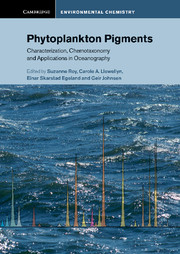Book contents
- Frontmatter
- Contents
- Contributors
- Preface
- Acknowledgements
- Abbreviations and symbols
- Part I Chlorophylls and carotenoids
- Part II Methodology guidance
- 4 New HPLC separation techniques
- 5 The importance of a quality assurance plan for method validation and minimizing uncertainties in the HPLC analysis of phytoplankton pigments
- 6 Quantitative interpretation of chemotaxonomic pigment data
- 7 Liquid chromatography-mass spectrometry for pigment analysis
- 8 Multivariate analysis of extracted pigments using spectrophotometric and spectrofluorometric methods
- Part III Water-soluble ‘pigments’
- Part IV Selected pigment applications in oceanography
- Part V Future perspectives
- Part VI Aids for practical laboratory work
- Part VII Data sheets aiding identification of phytoplankton carotenoids and chlorophylls
- Index
- Plate Section
- References
6 - Quantitative interpretation of chemotaxonomic pigment data
Published online by Cambridge University Press: 05 March 2012
- Frontmatter
- Contents
- Contributors
- Preface
- Acknowledgements
- Abbreviations and symbols
- Part I Chlorophylls and carotenoids
- Part II Methodology guidance
- 4 New HPLC separation techniques
- 5 The importance of a quality assurance plan for method validation and minimizing uncertainties in the HPLC analysis of phytoplankton pigments
- 6 Quantitative interpretation of chemotaxonomic pigment data
- 7 Liquid chromatography-mass spectrometry for pigment analysis
- 8 Multivariate analysis of extracted pigments using spectrophotometric and spectrofluorometric methods
- Part III Water-soluble ‘pigments’
- Part IV Selected pigment applications in oceanography
- Part V Future perspectives
- Part VI Aids for practical laboratory work
- Part VII Data sheets aiding identification of phytoplankton carotenoids and chlorophylls
- Index
- Plate Section
- References
Summary
Introduction
The use of pigments for the quantitative chemotaxonomic analysis of phytoplankton populations began in the 1970s when thin layer chromatography revealed a large diversity of pigments in the phytoplankton (Jeffrey, 1974), many of which appeared to be restricted to certain algal taxa and could be sensitively detected even in the presence of protozoa, bacteria and detritus, in which they are absent. Since that time, developments in phytoplankton systematics, particularly through DNA analysis (e.g. Karlson et al., 2010), have revealed a much greater taxonomic diversity in phytoplankton than previously imagined, while simultaneous improvements in chromatography have led to the identification of >70 pigments in 45 pigment patterns (tabulated in Jeffrey et al., Chapter 1, this volume). This provides substantial additional power in pigment analysis but also hugely complicates interpretation of pigment data. Relatively few pigments are now regarded as unambiguous markers – most are distributed across several taxa.
The pigment composition of microalgae is strongly influenced by several environmental factors that complicate interpretation of field data. A full synopsis is beyond the scope of this chapter, but known influences and key references include: irradiance (Johnsen et al., 1994; Goericke and Montoya, 1998; Schlüter et al., 2000; Rodríguez et al., 2006a), spectral distribution of light (Wood, 1985), ultraviolet (Gerber and Häder, 1994); day length (Sakshaug and Andresen, 1986), diurnal cycle (Tukaj et al., 2003), nutrient status (Goericke and Montoya, 1998; Henriksen et al., 2002; Stæhr et al., 2004; Hou et al., 2007), iron concentration (van Leeuwe and Stefels, 1998; DiTullio et al., 2007; Hopkinson et al., 2007), mixing regime (Brunet et al., 2003; Thompson et al., 2007) and growth phase (Wilhelm and Manns, 1991; Henriksen et al., 2002; Redalje et al., 2008). The pigment content can vary qualitatively between members of a genus, or even between strains of single species (Stolte et al., 2000; Zapata et al., 2004; Laza-Martinez et al., 2007). Thus the pigment content of a field population cannot be accurately predicted even if one knows the species present.
- Type
- Chapter
- Information
- Phytoplankton PigmentsCharacterization, Chemotaxonomy and Applications in Oceanography, pp. 257 - 313Publisher: Cambridge University PressPrint publication year: 2011
References
- 93
- Cited by

